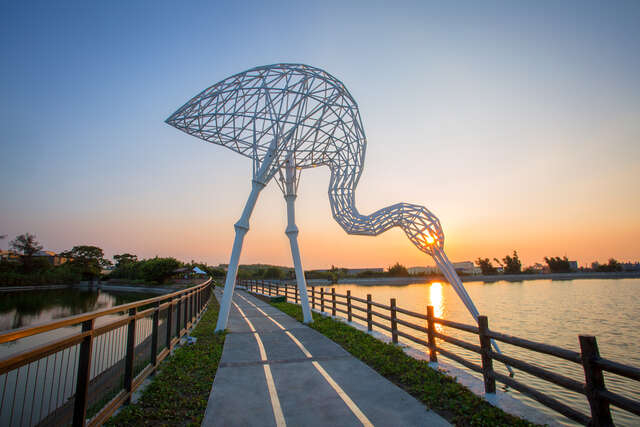Luminous Waves, Graceful White Shadows (Landscape Art Festival: White Egret) Introduction
Pond is a prominent natural landscape in Fugang, and the pond irrigation system represents the unique topography of the Taoyuan area. It was initially developed for agricultural irrigation needs, storing water and serving not only agricultural functions but also providing a rich food source from the fish and shrimp within the pond, creating an excellent environment that attracts birds for foraging and roosting. Agriculture, ponds, and natural ecology have developed a close symbiotic relationship. In recent years, due to the decline of agriculture, the abandonment of farmland, and land development, the number of ponds has rapidly decreased, and habitat destruction has led to a decline in bird populations. The pastoral beauty that once belonged to the communal memory of residents has gradually disappeared. The work "Rippling Waves, Fluttering White Shadows" by Professor Xu Zongjie uses the white egret, which coexists with the ponds, as the prototype for the artwork. In early agricultural society, the white egret was viewed as the guardian of crops and a lucky symbol for rural areas, accompanying farmers from dawn to dusk. During the spring plowing and autumn harvest, one could see the white egret strolling and foraging closely behind the water buffalo, creating a serene and content rural landscape. Since ancient times, the snow-white silhouette of the white egret has always been a source of inspiration for literati, as depicted in Li Bai's poem "The White Egret" from the Tang Dynasty: "The white egret descends upon the autumn waters, flying alone as if falling into frost. My heart hears but has not left, standing alone by the sandbar." The work reaches a height of 8.5 meters and creates a visual focus in the flat pond landscape, attracting passersby, whether driving along the outer ring road or taking the TRA train through Fugang. Located on the slope path connecting the upper and lower ponds, it leverages the unique environmental features of the pond by using the reflection on the water surface, allowing the public to leisurely view the artwork and its reflections from different angles along the lakeside path. The action of the white egret pecking for food cleverly connects the visuals of the upper and lower ponds through the artwork, enhancing the overall integrity of the Sanlian Pond landscape, allowing the artwork to blend naturally into the pond scenery. The Fugang area has a plateau terrain, and the installation site is close to the pond. The surrounding land is flat, but the northeast monsoon is strong. Therefore, the design of the artwork's hollow surface not only reduces weight and lowers wind impact but also allows the piece to retain spatial permeability and a sense of visual lightness. The towering scale not only provides optimal viewing conditions but also creates a contrast in proportions with the human figure, dramatically highlighting human insignificance and reflecting the need for humility towards nature. Historically, Fugang was a remote rural area until the establishment of the Bokong Station during the Showa period when the Northward moving trunk railway was constructed. The area gradually formed a street, and commercial activities began to concentrate near the old street. The construction of the railway not only brought convenient transportation to Fugang but also opened up a broader range of developmental possibilities in the future with the establishment of new factories. Just as this public art project selects local elements from Fugang as its installation concept, combined with the landscape conditions of the area, it aims to bring cohesion of memory and fresh cultural vitality to the people of Fugang through the locally symbiotic white egret. (Source: Cultural Affairs Bureau)







































